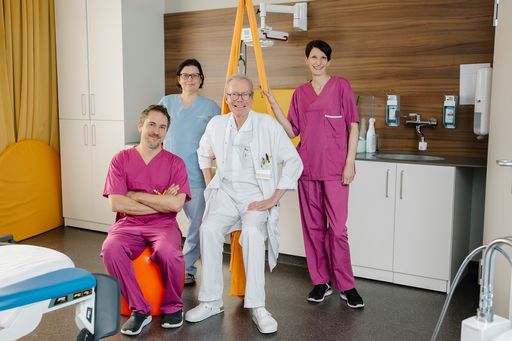In 2024, 4,152 births were cared for at St. Josef Hospital Vienna, of which 38 were twin births. A total of 4,190 babies were born in the religious hospital in Vienna’s 13th district last year – more than in any other Austrian hospital. In addition to very personal care, the team at the Parent-Child Center focuses on giving birth as naturally as possible, combined with the safety net of modern medicine.
“Even though we look after more than 4,000 births every year: for the team at the Parent-Child Center, every birth is special,” emphasizes Primarius Dr. Andreas Brandstetter, Head of the Department of Gynecology and Obstetrics at St. Josef Hospital Vienna. In addition to the large obstetric center, the parent-child center also has a modern children’s department with neonatology.
The birth statistics in detail
In 2024, 4,152 births were cared for at St. Josef Hospital Vienna, of which 38 were twin births. Of the 4,190 babies born in the religious hospital, 2,152 were boys (51%) and 2,038 were girls (49%). While with the boys “Felix” the most popular name was “Olivia” topped the list of the most common names for girls in 2024. The average weight of the babies born in St. Josef Hospital Vienna was 3,382 grams. The heaviest baby weighed 4,870 grams; the lightest child weighed 867 On average, 11.4 births per day were cared for in St. Josef Hospital Vienna in 2024, but the actual number per day can vary greatly Only five percent of all children were born on the expected date of birth. The cesarean section rate was 30.3 percent. “Despite the size of the department and the care of high-risk births,” said Primarius Brandstetter. According to Statistics Austria, the cesarean section rate was Austria in 2023 at 32.4 percent.
Comprehensive care in a family environment
In the Parent-Child Center at St. Josef Hospital Vienna, expectant mothers have access to a large maternity area with eleven delivery rooms, a separate operating room for cesarean sections, two postpartum wards and various outpatient rooms. “Despite the high number of births, we try to create a family environment in which women and their babies feel comfortable. Our team of doctors, midwives and nursing staff is certainly essential for this. They all care intensively and, above all, very personally for the patients – during appointments during pregnancy, during birth and during the postpartum period,” says Primarius Brandstetter. The modern equipment in the maternity area also ensures a good atmosphere. “The delivery rooms used to be as sterile as an operating room; today they have more of the character of a living room,” describes Brandstetter. “The technical equipment is hidden behind wooden paneling, there is a couch for the accompanying person, and the lights are dimmed. The women can move freely and adopt different birthing positions.”
The hospital is also known for its focus on giving birth as naturally as possible – combined with the safety net of modern medicine. A key element is the midwife-led birth: As long as everything goes smoothly and the medical parameters are normal, the women are cared for by a midwife. “The experienced and well-trained medical team is usually only called in if there are problems during the birth or if the woman expressly requests it,” says Brandstetter. Primarius Dr. Roland Berger, head of the pediatric department with neonatology, adds: “The delivery area and neonatology are right next to each other. If the baby feels poorly after birth, the doctors and nurses from the neonatology department are also on site to provide support.”
OTS ORIGINAL TEXT PRESS RELEASE UNDER THE EXCLUSIVE RESPONSIBILITY OF THE SENDER FOR CONTENT – WWW.OTS.AT | VGK
